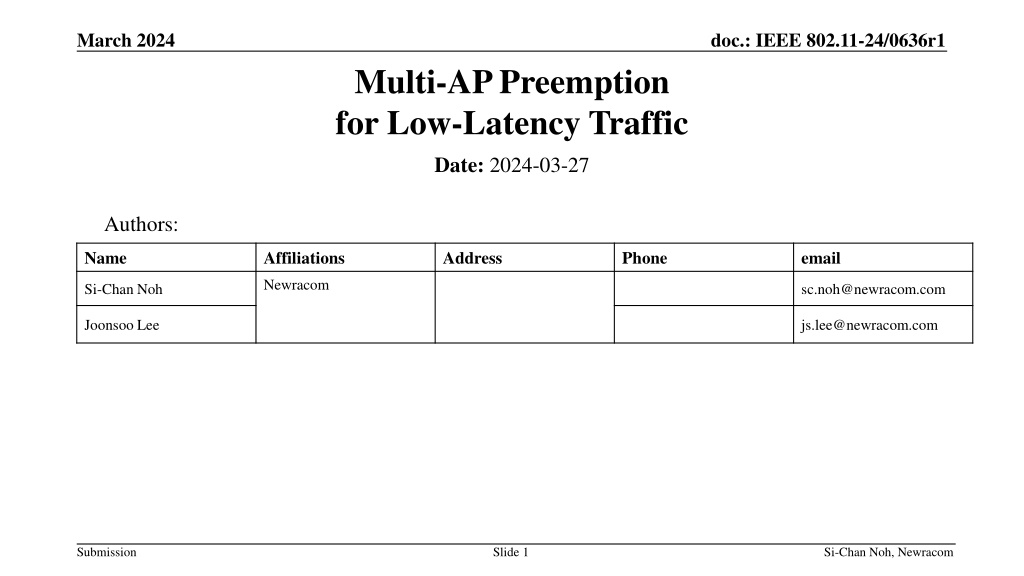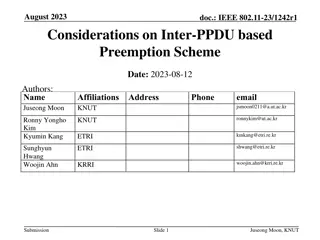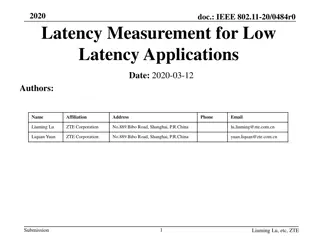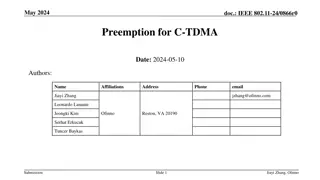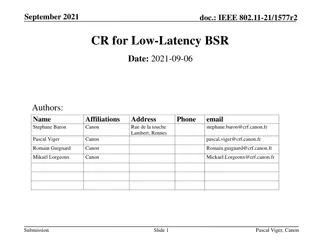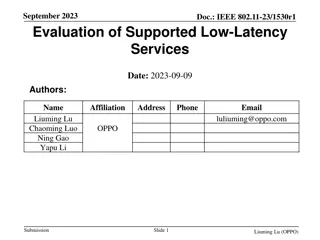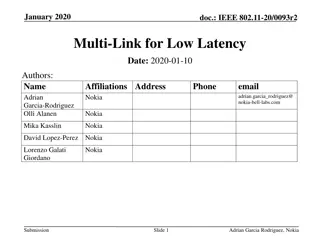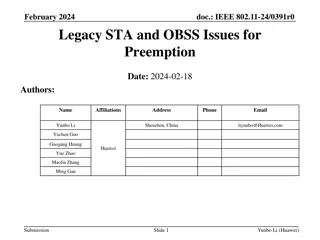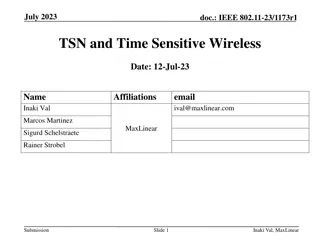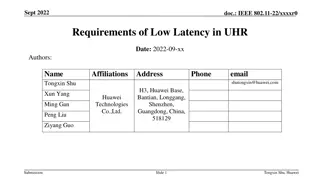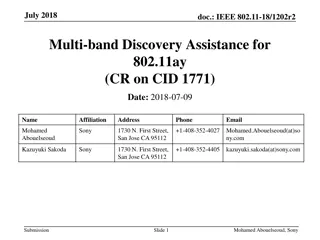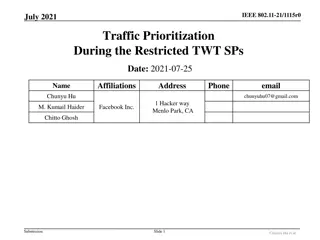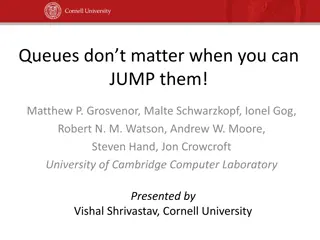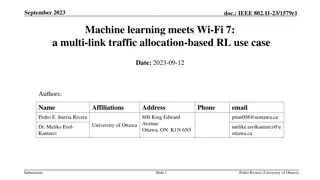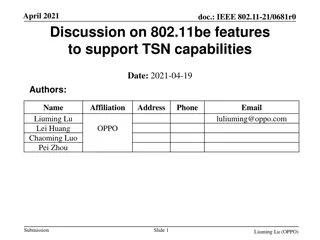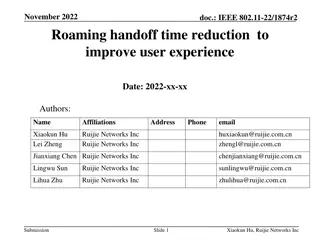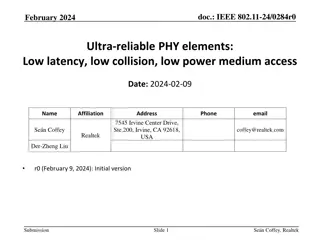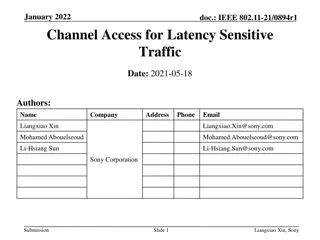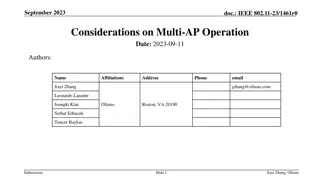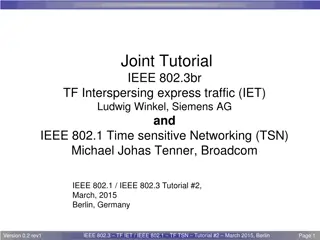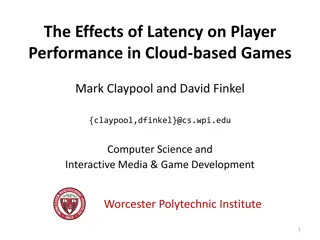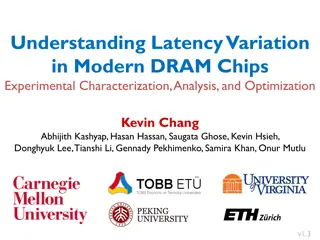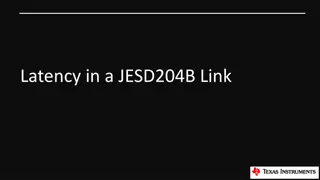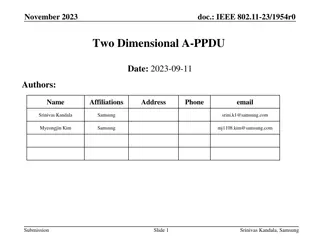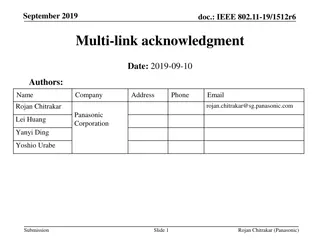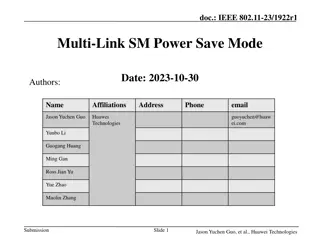Multi-AP Preemption for Low-Latency Traffic in IEEE 802.11 Networks
Discussion on the necessity of Multi-AP preemption for low-latency traffic in IEEE 802.11 networks. Addresses issues related to latency-sensitive traffic in overlapping basic service sets (OBSS). Proposes a general solution to enable OBSS APs to transmit urgent low-latency traffic without significant delays.
Download Presentation

Please find below an Image/Link to download the presentation.
The content on the website is provided AS IS for your information and personal use only. It may not be sold, licensed, or shared on other websites without obtaining consent from the author. Download presentation by click this link. If you encounter any issues during the download, it is possible that the publisher has removed the file from their server.
E N D
Presentation Transcript
March 2024 doc.: IEEE 802.11-24/0636r1 Multi-AP Preemption for Low-Latency Traffic Date: 2024-03-27 Authors: Name Affiliations Address Phone email Newracom Si-Chan Noh sc.noh@newracom.com Joonsoo Lee js.lee@newracom.com Submission Slide 1 Si-Chan Noh, Newracom
March 2024 doc.: IEEE 802.11-24/0636r1 Introduction Preemption has been discussed in UHR SG and 11bn TG to support low latency application in different scenarios [1-4] Most of the contributions are discussing preemption techniques in UL/DL TXOP cases to support DL/UL latency sensitive traffic within single BSS [1-4] However, when the OBSS APs have a low latency sensitive traffic, it cannot support its LL traffic through single BSS preemption and wait until the end of the ongoing TXOP of other BSS s This contribution discuss about general Multi-AP preemption method and some issues focusing on where the OBSS APs have latency sensitive traffic to be transmitted urgently Submission Slide 2 Si-Chan Noh, Newracom
March 2024 doc.: IEEE 802.11-24/0636r1 Recap - [5] In the previous contribution, we discussed returning TXOP of shared AP to sharing AP through PR Enabled/PRI frame in C-TDMA In this contribution, we share our thoughts of Multi-AP Preemption in more general scenarios when OBSS APs have LL traffic to be transmitted urgently Submission Slide 3 Si-Chan Noh, Newracom
March 2024 doc.: IEEE 802.11-24/0636r1 Problem Statement When an AP reserves the medium, the other OBSS APs cannot transmit LL traffic until the end of ongoing TXOP The LL traffic could be handled through several coordinated AP techniques For example, LL traffic could be handled at the membership AP on the R-TWT schedule between APs or shared AP side during allocated time in C-TDMA Those techniques can handle LL traffic when the STA gets TXOP Moreover, after completion of ongoing TXOP, we may not guarantee of transmitting LL traffic due to the contention with other devices If we can extend single BSS s preemption mechanism to multi-AP preemption, we can grant an opportunity to OBSS APs to transmit its LL traffic without large delay Submission Slide 4 Si-Chan Noh, Newracom
March 2024 doc.: IEEE 802.11-24/0636r1 General solution for Multi-AP Preemption TXOP holder AP can send a PR Enabled indication to grant preemption opportunity for OBSS APs which has LL traffic Here, the PR Enabled indication for Multi-AP preemption can be identified only between APs The PR Enabled indication can be included in immediate response frame (e.g., BA) or small DL PPDUs The OBSS APs can transmit Preemption Traffic Indication (PRI) After receiving PR enabled, the OBSS AP can transmit PRI When the OBSS APs set NAV due to the previous frame exchange of TXOP holder BSS, it can neglect it and can transmit PRI Option 1 : xIFS(e.g., xIFS > xIFS ) after the immediate response frame Option 2 : xIFS(e.g., xIFS > xIFS ) after the small DL PPDUs After transmitting PRI, the OBSS APs can start contending (e.g., EDCA-based) The OBSS APs which are send PRI frame may participate contention to support LL traffic Submission Slide 5 Si-Chan Noh, Newracom
March 2024 doc.: IEEE 802.11-24/0636r1 Some issues in Multi-AP Preemption Ignoring NAV value when the OBSS APs try to transmit PRI The NAV can be set not only due to TXOP holder BSS s frame exchanges also updated from third party STA In case of when third party STA is hidden to the TXOP holder BSS, transmitting PRI frame can affect third party STA s frame exchanges Hidden node issues STAs associated to TXOP holder AP may not overhear PRI from LL clients(i.e., APs), it can affect interference Moreover, if the OBSS APs are hidden to each other, the collision can be happened The TXOP holder AP could not aware of ending time of OBSS AP s frame exchanges OBSS AP_1 and OBSS AP_2 are hidden each other OBSS AP_2 may success preemption and finish its LL traffic frame exchanges However, OBSS AP_1 may think the medium is IDLE, it can start its frame exchanges TXOP holder AP may not expecting the ending time of LL traffic frame exchanges The other issues can be happened during when allowing Multi-AP preemption and address those issues can be too complicated or it may bring too many restrictions Submission Slide 6 Si-Chan Noh, Newracom
March 2024 doc.: IEEE 802.11-24/0636r1 Some issues in Multi-AP Preemption Appropriate scenarios for allowing Multi-AP preemption Allow Multi-AP preemption in more protected scenarios can be better way to relieve those issues Such as Coordinated APs techniques can be one of the protected scenario and it can be more efficient way in terms of latency and efficiency compared to in general scenarios For example, when we assume well protected C-TDMA scenario: Sharing AP and shared AP identify each other, and can easily monitor their frame exchanges The Shared AP can allow preemption for the sharing AP, and vice versa After supporting LL traffic, the shared AP can resume its TXOP Submission Slide 7 Si-Chan Noh, Newracom
March 2024 doc.: IEEE 802.11-24/0636r1 Summary In this contribution, Multi-AP Preemption is discussed to support OBSS AP s LL traffic without large delay However, some issues exist in Multi-AP Preemption Some details should be discussed to allow preemption at AP s level Submission Si-Chan Noh, Newracom
March 2024 doc.: IEEE 802.11-24/0636r1 Reference [1] 23/0092r0, Preemption [2] 23/1229r0, Preemption for Low Latency Application (follow up) [3] 23/1886r3, Preemption techniques to meet low-latency (LL) targets [4] 24/0168r0, TXOP preemption in 11bn [5] 24/0375r0, NAV protection for C-TDMA Submission Si-Chan Noh, Newracom
